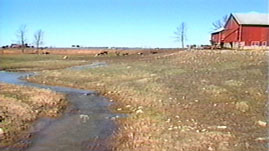Teachers' Domain - Digital Media for the Classroom and Professional Development
User: Preview

Source: Common Ground and Cleaner Water
Farming has always meant more than cultivating crops and raising animals. In this KET video from Common Ground and Cleaner Water, learn from a third generation farmer what it means to protect the land for future generations by caring about water quality on his farm and on his neighbors' farms down stream. See how building a containment pond helps prevent animal waste from polluting streams and helps fertilize crops.
Water pollution can occur in both densely populated and rural areas. Farmers have traditionally understood the importance of good stewardship of the land, but small farming operations often have to balance their need to realize a profit for their labor with sometimes costly efforts to reduce pollution.
Pollution is anything that, by its nature or its concentration, adversely affects the environment and human health. When pollution can be identified as coming from a particular source, such as a factory, a malfunctioning sewage treatment system, or a large livestock farm, it is described as point source pollution. The Federal Water Pollution Control Act (1972), also known as the Clean Water Act, and the Oil Pollution Act (1990) have resulted in changes in common practices at point sources, which have significantly reduced the amount of pollution emitted from those sources.
When the source of the pollution is not clear, or when pollution results from the accumulation of many everyday acts of individuals, it is described as non-point source pollution. Efforts are being made to reduce water pollution from diffuse, non-point sources such as residential lawns, paved surfaces, building sites, and small agricultural operations. Pollution from these sources generally occurs when rainwater flows across the surfaces and picks up dirt, motor oil, fertilizers, pesticides, bacteria, and animal waste, and then transports them to adjacent waterways. While individual farms, lawns, and roads produce relatively small quantities of pollutants, there are so many of these non-point sources that their collective effect makes non-point source pollution the greatest current threat to America's water quality.
Reducing non-point source water pollution from an agricultural operation is a multifaceted task. Manure, other fertilizers, insecticides, and/or herbicides are each important elements of farming, but once spread upon the land, they may wash off during rainfall and cause harm to waterways.
One of the biggest problems is determining how to responsibly handle animal waste. Manure naturally contains bacteria and viruses. These organisms are necessary for the decomposition of organic waste matter, but are potentially harmful if they enter the water supply in large amounts.
Manure also naturally contains nitrogen, phosphorus, potassium, and other nutrients for plants, making it a useful fertilizer if applied to croplands in appropriate quantities and at proper times. However, excessive nutrients in waterways lead to algal blooms, which eventually die, decompose, and cause lower concentrations of dissolved oxygen, killing fish and other organisms in a process known as eutrophication.
Fencing livestock out of streams is one way to keep manure from landing directly in the water. Other solutions are to roof livestock feedlots and manure stack pads to keep rainwater or snowmelt from causing runoff. Or, as with Tribby Vice’s farm, the runoff can be directed to a containment pond for future irrigation use.
Another effective strategy to prevent cropland runoff from reaching waterways is to plant a buffer strip of dense vegetation between the waterway and the crop. This slows the flow of runoff, allowing more water and its transport load, including fertilizers, insecticides, herbicides, and sediment, to be deposited on land instead of entering the waterway. Contour plowing and other practices that prevent soil erosion, responsible management of animal waste, and use of beneficial insects to control pests and reduce the need for pesticides are other strategies for reducing non-point source pollution in agriculture.
To learn more about another solution to non-point source pollution, check out Invalid resource code: ket08.sci.life.earthsys.urbasol.
To learn about efforts to clean up pollution in another environment, check out Pollution Along the Rhine River.
 Loading Standards
Loading Standards